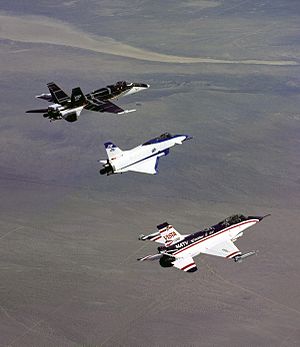F-16 VISTA
| F-16 VISTA | |
|---|---|
 |
|
| The VISTA/MATV aircraft in formation with the X-31 (middle) and the F/A-18 HARV (top) | |
| Role | Experimental fighter |
| Manufacturer |
General Dynamics (later Lockheed Martin) and Calspan |
| Number built | 1 |
| Developed from | General Dynamics F-16 Fighting Falcon |
The General Dynamics (now Lockheed Martin) F-16 VISTA ("Variable stability In-flight Simulator Test Aircraft") is an experimental aircraft, derived from the F-16 Fighting Falcon, which was modified as a joint venture between General Dynamics and Calspan for use by the USAF.
The F-16 VISTA testbed aircraft incorporated a multi-axis thrust vectoring (MATV) engine nozzle that provides for more active control of the aircraft in a post-stall situation. The resulting aircraft is supermaneuverable, retaining pitch and yaw control at angles of attack beyond which the traditional control surfaces cannot change attitude.
The VISTA program was considered successful, but the thrust vector control (TVC) never made it into production fighter versions.
The program was also notable for the development of Direct Voice Input and the "Virtual HUD", which were both eventually to be incorporated into the cockpit design for the F-35 Lightning II. The STOVL F-35 variants also incorporate MATV while hovering to provide attitude control.
The VISTA aircraft is now operated and maintained by Calspan for the US Air Force Test Pilot School out of Edwards Air Force Base, CA. It is regularly used in student curriculum sorties, and other special academic projects.
The F-16 VISTA is a Block 30 F-16D based on the airframe design of the Israel Air Force version, which incorporates a dorsal fairing running the length of the fuselage aft of the canopy and a heavyweight landing gear derived from the Block 40 F-16C/D. The fairing houses most of the variable-stability equipment and test instrumentation. The heavyweight gear will permit simulation of aircraft with higher landing sink rates than a standard F-16.
...
Wikipedia
